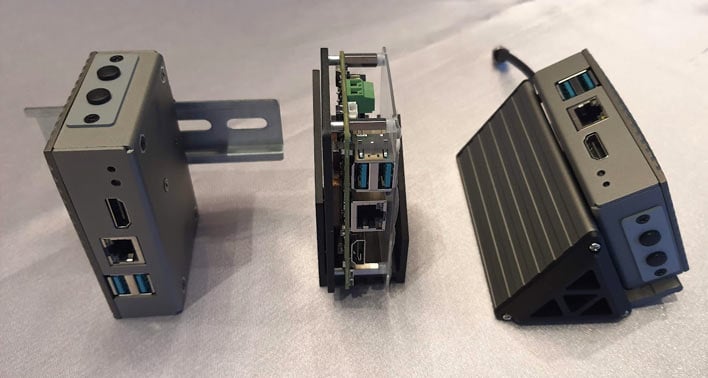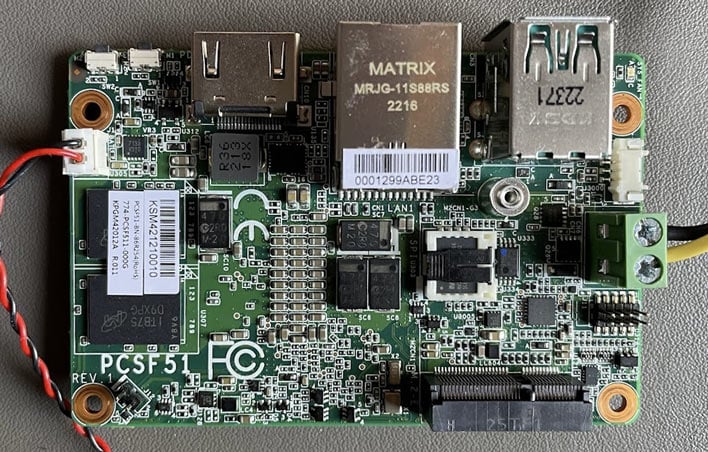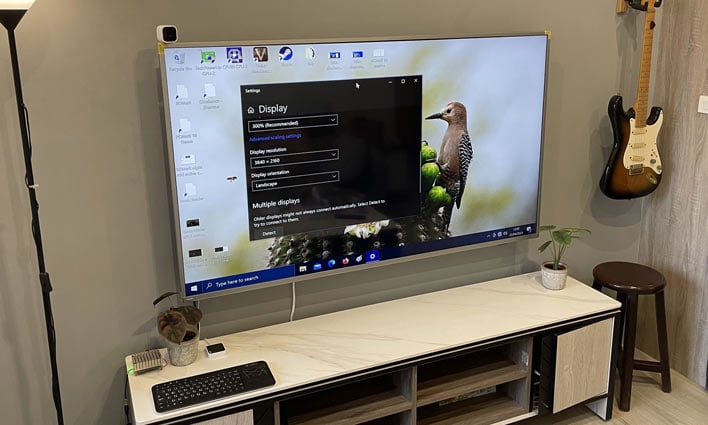DFI PCSF51 Review: A Credit Card Sized Ryzen Powered Mini PC
DFI PCSF51: Inspecting An AMD-Powered Industrial Pi Single Board Computer
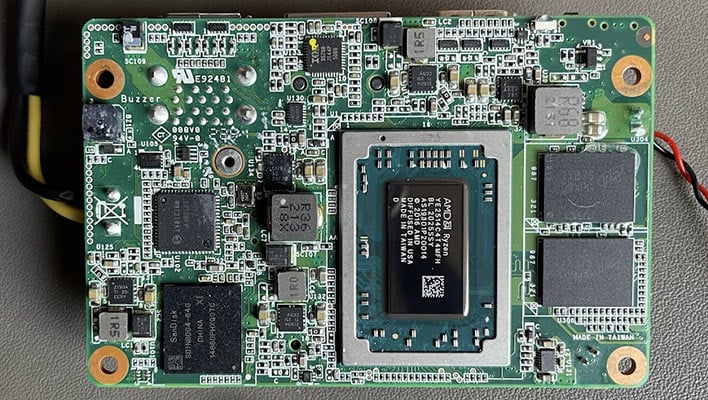
| DFI PCSF51 Industrial Pi: $580 (As Tested) + $28 Passive Heatsink The DFI PCSF51 is an 'Industrial Pi', powered by an AMD Ryzen Embedded R2000 processor for intensive and demanding edge applications.
|
|||

|

|
||
DFI announced its new PCSF51 1.8-inch Single Board Computer (SBC) at Embedded World 2023 in mid-March. We reported on the news at the time, and we were lucky enough to meet up with the DFI team in Taiwan a couple of weeks later. They had a few PCSF51 boards with them, and various interesting chassis prototypes, so we managed to squirrel one away for testing.
The DFI PCSF51 certainly looks promising on paper, for a tiny credit card sized SBC. Compared to the previous model, the similarly named GHF51, it has a newer gen AMD Ryzen Embedded APU (moving from the R1000 to the R2000 series). This means newer CPU and GPU cores come into play, and the new PCSF51 can deliver up to 50% faster CPU performance, and 15% faster GPU performance than its predecessor, according to the slides provided by DFI at least. AMD's Ryzen Embedded R2000 Series were released back in October 2022, but use the relatively aged Zen+ processor and Vega graphics architectures.
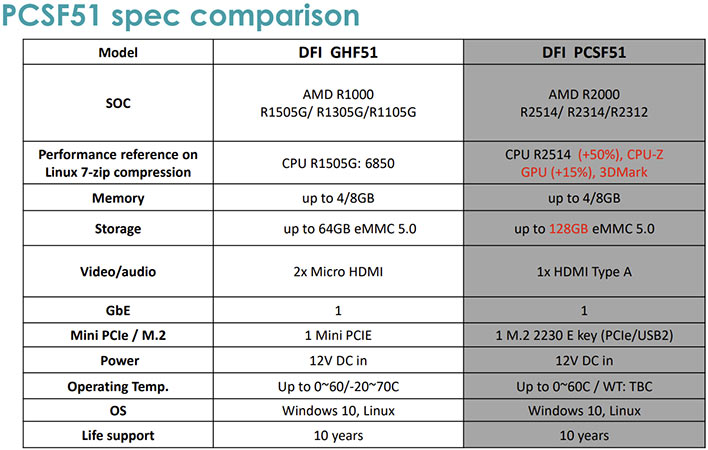
The popularity of the older DFI GHF51 ‘Industrial Pi’ was a pleasant surprise for the company. So, as well as upgrading the APU to the latest generation, a number of other changes were made after listening to customer feedback. While Memory capacity options remain the same (4 or 8GB DDR4), the maximum onboard eMMC 5.0 storage has been increased to 128GB. Instead of the fiddly little pair of micro-HDMI ports, the new model has a full size HDMI 1.4 port. Elsewhere, there is an M.2 2230 port for Wi-Fi / Bluetooth cards, a 1GbE RJ45 port, twin USB3.1 Gen2 Type-A ports, fTPM2.0, and an 8-bit DIO.
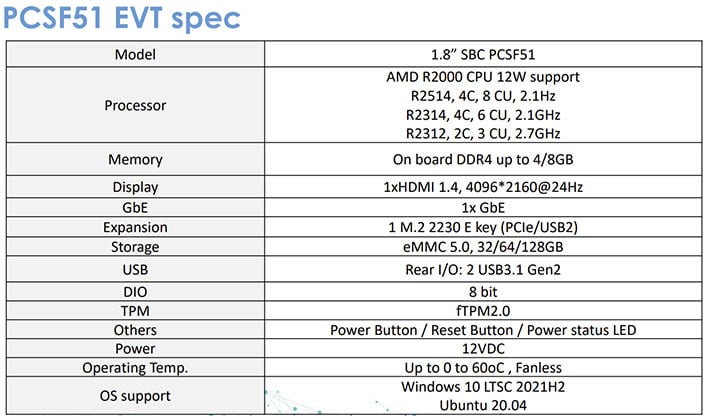
The unit is powered by a 12V/5A adaptor, and the other dangling wire you see in the hero image at the top, with a yellow blob at the end, is a CR2032 battery for the real-time clock. Lastly, on the same edge as the ports mentioned above, there are power and reset buttons, as well as a power status LED. The board is claimed to support Windows 10 LTSC 2021H2 and Ubuntu Linux 20.04. The one we tested came with Windows 10 LTSC pre-installed, but not activated.
Unboxing The DFI Ryzen SBC
We are more accustomed to consumer-facing products than industrial fare, so the DFI PCFS51 offered a few surprises. The plain-ish brown box was an understandable decision. It's about the size of a typical PC motherboard, and stirred some feelings of nostalgia for DFI LAN Party motherboards from years past. Inside the very ordinary looking and surprisingly large power supply is presented first. Consumers might shudder at such a power brick for a “12W SBC,” but we understand this is an industrial no-frills PSU that's designed to long terms use and high reliability. It was interesting to see how it wires up to a locking barrel jack, which in turn has two wires screwed to the SBC.
One of the important choices for DFI PCSF51 buyers will be its cooler. We tested three different models: a passive unit that more or less matched the XY dimensions of the SBC at 85 x 60mm and 25mm thick, a bulkier passive unit at 115 x 75 x 27mm, and an active fan unit at 85 x 60mm and 17mm thick. After lengthy experimentation, we judged that the smaller passive heatsink wasn't up to cooling for our purposes (entertainment) as the DFI PCSF51's APU throttled under sustained workloads. We didn't like the active cooler either, as its fan was a bit noisy (3000rpm fixed speed). Thus, we picked the Goldilocks cooler for our purposes, the passive (and hence silent) but chunky 115 x 75mm footprint unit.
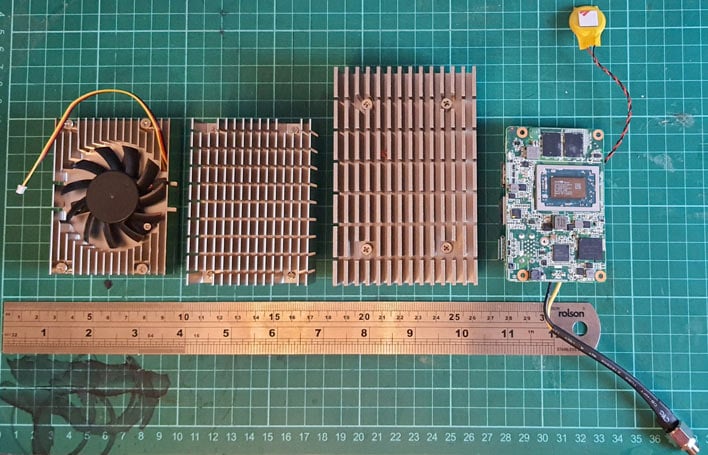
Preparing The DFI PCSF51 For Testing
Our initial plan for the DFI PCSF51 was to cramit into a really tiny Home Theater PC (HTPC). Sometimes smart TVs aren’t smart enough, and a PC is just so much more flexible. DFI’s 1.8-inch SBC is so small it could easily hide out of sight, perhaps mounted to the TV rear, keeping the living room minimalistic, but with plenty of multimedia punch. But first things first, this SBC needs testing in a wide range of system and performance component benchmarks.

